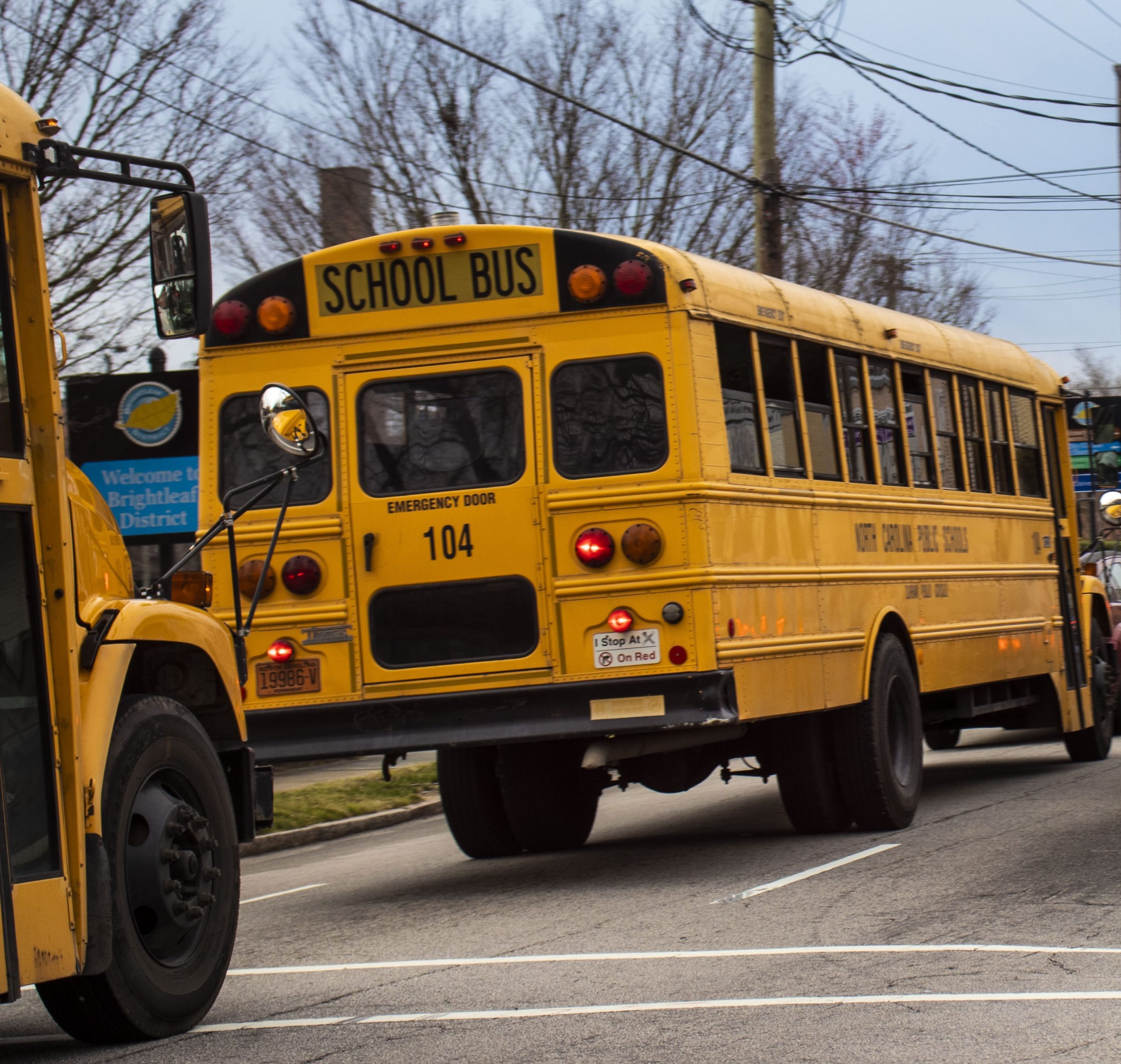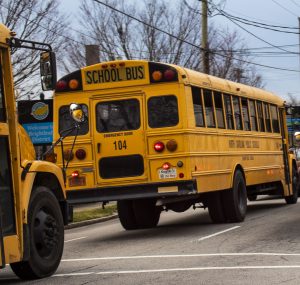“Who’s not going to their job this morning?”
It’s a question Jane Dornemann has asked one too many times.
Dornemann, mother of a Durham School of the Arts sixth grader, works as an end-of-life doula and writer. Her husband, Colin, is an engineering specialist for HVAC systems.
On Oct. 9, the couple was forced to decide which parent should miss work to drive their son August to school.
When Dornemann awoke that morning, she received a notification through Edulog Parent Portal App, the school transportation tracking app, that her son’s bus would be about 40 minutes late. Typically, his bus arrives at around 7:40, though with the delay the exact arrival time was impossible to know.
Dornemann’s client would be in hospice at 8 a.m. Her husband had to leave for work at 7 a.m.
Ultimately, Dornemann’s husband missed work to drive August to school.
“I would say for many of us, at least half the days we have no driver. There’s no bus at all,” Dornemann said about her son’s bus route.
Since the beginning of the school year, DPS has faced an ongoing bus driver shortage. Two months in, the problem persists.
In an email message sent to parents and staff in mid-October, the district acknowledged the challenge of transporting students to and from school.
“We remain firmly committed to this very important goal,” the message read. “But admittedly, we continue to experience significant challenges in being as consistent with timely service as we would like to be.”
Also in the email, the district asked parents to search for different methods to get their child to school.
“When possible, we ask that you find an alternate solution for getting your child to school. While we know this is an impossibility for many families…we ask parents to take their children to school,” the message read.
So far, the district has taken steps to tackle the transportation challenges. The school system received permission from the North Carolina Department of Motor Vehicles to reduce the driver training timeline, school administrators have been asked to accommodate bus-related tardiness and absence, and the district is working with Edulog representatives to better train drivers how to use the portal.
Yet despite these measures, morning chaos like the Dornemanns’ has become familiar to many parents.
Heather Banta’s daughter, Reine, is a sixth grader at Githens Middle School. Like the Dornemanns, Banta leaves for work early each morning, a schedule that conflicts with driving her daughter to school every day. Banta’s work day is supposed to start at 8 a.m., but school drop-off for Reine is at 8:30 a.m. For Banta, the bus is essential.
A first-time bus rider, Reine waited excitedly with her mother and a group of other families at their assigned stop on the first day of school. However, when another parent said the location and timing of the bus stop had changed, Banta was unsure what to do.
“The bus was about 45 minutes late at this point, we’re calling DPS transportation, trying to figure out if it’s coming.” Banta said. “And then we see it coming up the street, and the kids are jumping up and down with excitement, and the bus just goes sailing right past us.”
Banta ended up driving her daughter to school — as well as another child whose parents were unable to wait with her at the stop.
At a September work session, superintendent Anthony Lewis said that transportation services may be less responsive as 10 members of transportation’s administrative staff were filling in as drivers.
On Sept. 18, Banta wrote an email to the school board members expressing her concerns, and complaining about “lack of communication from DPS Transportation.” In an email reply, board member Bettina Umstead thanked Banta for sharing her experience and copied the superintendent and Todd LoFrese, the interim chief operating officer. Banta has not received any additional response.
Since the first month of the school year, Banta said that Reine’s bus has generally been more consistent. Just last week, though, Banta received an Edulog notification that her daughter’s bus would be 45 minutes late. Banta rearranged work meetings and drove Reine and another neighborhood child to school. Turns out, the bus arrived at the stop on time with no delay, another parent informed Banta later that morning.
Most DPS students — 18,813 out of 31,165 total — ride the school bus, requiring 165 daily bus drivers. Between August and September, rider requests increased by nearly 5,000 students, according to Lewis.
In the message to parents earlier this month, the district said it is short about 30 bus drivers. The same estimate was provided to The 9th Street Journal in September by Mathew Palmer, senior executive director of school planning and operation services.
A shortage of bus drivers is a nationwide dilemma for school systems, a problem that worsened during the COVID-19 pandemic. An analysis by USA Today found that every state in the country experienced one instance of a significant school bus driver shortage in 2023.
In North Carolina, the neighboring Wake County school system has encountered similar challenges. Last year, Wake announced that 2,000 students would need to find their own transportation to school because 17 bus routes were missing drivers. The shortage has lessened since then, with Wake schools saying they will be able to cover all bus routes this school year.
School bus drivers in Durham are paid between $19 and $28 per hour based on experience, a rate competitive with that of neighboring districts. Wake County schools increased starting bus driver pay to $20 this year, the same pay rate for drivers in Chapel Hill-Carrboro City Schools. In 2022, Orange County Schools increased starting pay to $17.
At a school board meeting on Oct. 24, Christy Patterson, vice president of the Durham Association of Educators, called on the school board to listen to drivers’ frustrations.
”You have to listen when…they tell you about the disrespect and favoritism they have to put up with,” Patterson said. “The powerlessness they feel when they are mistreated by supervisors, the frustration when they have to drive 20 minutes across town in between routes or when they’re supposed to drop kids off in an unsafe stop or when there are behavior issues on the bus and they receive no support.”
The Durham school board planned to discuss the ongoing transportation issues at last Thursday’s meeting. However, the presentation was delayed until early November.
In a Powerpoint presentation released ahead of the meeting, DPS administrators listed six tactics to address the transportation issues. The approaches ranged from a “dual employment” strategy — where some new employees will be required to obtain a school bus driver license — to establishing a 1.5-mile walk zone around certain schools.
During public comment at Thursday’s meeting, Megan DeLuca, a parent of three DPS students, criticized the proposed tactics.
“The solutions that are proposed in the slide deck are at worst, just out of touch…at best they’re just too small,” said DeLuca.
The driver shortage has taken an emotional toll on students like Reine and August. Banta said her daughter has been anxious over the transportation issues while Dornemann said her son has been “depressed by it.”
On Monday, August’s bus was two-and-a-half hours late in the morning and did not run in the afternoon.
He did not go to school.
Editor’s note: An earlier version of this story included a higher number of bus riders in Durham Public Schools, based on a DPS presentation. The school system has since provided a different tally, and the story has been updated to reflect that recent information.



